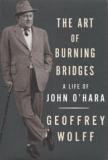Still a Mick
Ernest Hemingway’s famous comment about taking up a collection and sending John O’Hara off to Yale once for all may have been a cheap shot, but it was one O’Hara’s boorish streak nearly begged for.
In his unorthodox yet enlightening new biography, Geoffrey Wolff makes the case that readers should revisit O’Hara’s better work, such as his smash debut novel Appointment in Samarra, as well as the short stories, such as the powerful, autobiographical “The Doctor’s Son.”
Wolff, however, fails in his halfhearted efforts to rehabilitate O’Hara’s reputation. Many times throughout The Art of Burning Bridges, Wolff himself seems to throw up his hands and acknowledge O’Hara’s insufferably loutish behavior.
O’Hara was a very successful writer, a good father and there have been worse husbands. But he drank hard. And drunk or sober, more often than not, O’Hara was nasty and spiteful. He craved respect, yet when it came in the impeccable form of a Paris Review interview request, O’Hara turned them down. Hadn’t they first interviewed that hack Hemingway?
True, O’Hara’s bitterness was rooted in his sense of being an outsider. “Of all the social complexities that spurred John O’Hara’s anger, pride, envy, squinting focus, truculence, and art, his Irishness led the charge,” writes Wolff, author of three well-received nonfiction books, a memoir and six novels. “His Irishness was the obdurate wall against which John O’Hara beat his fist and the ivied, protective wall behind which he huddled with his clan.”
A big Irish Catholic clan it was, growing up in Pottsville, Pa. This was Molly McGuire country in the late 19th century, where coal mines—and labor strife—dominated people’s lives, rich and poor. But O’Hara was much closer to the former group. He was born in 1905, one of eight children. John’s Dad was a respected, middle class doctor, though the O’Haras were made to feel like outsiders in the heavily Protestant area. (This was further complicated by the fact that the lace curtain O’Hara encouraged John to “avoid the company of rough Catholic kids.”)
The budding author was never much of a student anyway. He floated into and out of different schools, eventually deciding to go for broke and move to New York. Few smarter moves have ever been made in literary history. It was a struggle at times but O’Hara would become a prolific New Yorker contributor, best-selling novelist and even a hit on Broadway.
O’Hara’s first novel (published in 1934), Appointment in Samarra, sold well, though many critics panned it, as they did with much of his later work. This only fueled O’Hara’s inner demons.
He rubbed elbows (and often threw fists) with the likes of Dorothy Parker and F. Scott Fitzgerald at “21” and the Stork Club and even out in Hollywood. These represent some of the strongest sections in Wolff’s book, which is highly informal with many digressions. This may annoy some readers, yet it also makes for seamless, casual reading, with the appropriate dash of blunt, salty language. Wolff’s interpretive skills are excellent, though there is ultimately a heft, a thoroughness lacking in The Art of Burning Bridges. This is in part a result of the fact that there are already several authoritative O’Hara biographies out there.
Still, The Art of Burning Bridges ultimately sheds important light on O’Hara’s best work, particularly his groundbreaking treatment of sexuality. That said, Wolff tells us little about how O’Hara interacted with his family as the years went on. Furthermore, Wolff could have simply been more judgmental, and delved more deeply into why O’Hara—whose life was arguably quite charmed from cradle to grave—refused to see his glass of whiskey and water as half full. “If I am [a sorehead] it may be because I have been clouted on the skull so many times,” he said.
This is not necessarily untrue. But it sets the hardship bar rather low. Moreover, if O’Hara had written himself as a fictional character, it’s a good bet any typical O’Hara protagonist would have had no use for this bitter, successful, nattily-dressed fellow. Wolff himself touches upon this, writing: “[I]n many good writers’ best work they understand and elucidate weaknesses that in their lives they are powerless to control.”
Indeed, one character in Butterfield 8 raises questions about O’Hara which, in the end, Wolff’s book does not quite answer, perhaps because they cannot be answered.
“I want to tell you something about myself that will help to explain a lot of things about me. You might as well hear it now. First of all, I am a Mick. I wear Brooks [Brothers] clothes and I don’t eat salad with a spoon and I probably could play five-goal polo in two years, but I am a Mick. Still a Mick.”
This article also appeared in print, under the headline “Still a Mick,” in the February 16, 2004, issue.








